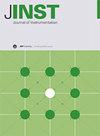用于液氩探测器位置重建的神经网络
IF 1.3
4区 工程技术
Q3 INSTRUMENTS & INSTRUMENTATION
引用次数: 0
摘要
本文探讨了深度学习和可解释人工智能在粒子物理学中的融合,重点是它们在暗物质搜索的双相液氩探测器中的位置重建应用。面对堆积场景等挑战,神经网络被证明是完善算法的关键。本文强调了深度学习在解决回归和分类问题中的作用,如位置重建和粒子识别,特别是在时间投影钱柜娱乐中。可解释人工智能(Explainable Artificial Intelligence)在揭示深度学习的复杂决策、暴露偏差和促进改进周期方面发挥着关键作用。进化神经网络和拓扑驱动的数据集缩减等创新技术为提高效率提供了可能。结论强调了在分析海量数据时所面临的挑战,强调了在理解暗物质的过程中需要有适应性和道德考量。本文章由计算机程序翻译,如有差异,请以英文原文为准。
Neural Networks for position reconstruction in liquid argon detectors
This article explores the integration of Deep Learning and Explainable Artificial Intelligence in Particle Physics, focusing on their application in position reconstruction within dual-phase liquid argon detectors for Dark Matter search. Facing challenges like pile-up scenarios, Neural Networks prove crucial for refining algorithms. This article emphasizes Deep Learning's role in addressing regression and classification problems, such as position reconstruction and particle identification, particularly in Time Projection Chambers. Explainable Artificial Intelligence emerges as pivotal in unraveling Deep Learning's complex decisions, exposing biases, and facilitating improvement cycles. Innovations like Evolutionary Neural Networks and topology-driven dataset reduction offer potential efficiency gains. The conclusion highlights challenges in analyzing massive data volumes, emphasizing the need for adaptability and ethical considerations in the pursuit of understanding Dark Matter.
求助全文
通过发布文献求助,成功后即可免费获取论文全文。
去求助
来源期刊

Journal of Instrumentation
工程技术-仪器仪表
CiteScore
2.40
自引率
15.40%
发文量
827
审稿时长
7.5 months
期刊介绍:
Journal of Instrumentation (JINST) covers major areas related to concepts and instrumentation in detector physics, accelerator science and associated experimental methods and techniques, theory, modelling and simulations. The main subject areas include.
-Accelerators: concepts, modelling, simulations and sources-
Instrumentation and hardware for accelerators: particles, synchrotron radiation, neutrons-
Detector physics: concepts, processes, methods, modelling and simulations-
Detectors, apparatus and methods for particle, astroparticle, nuclear, atomic, and molecular physics-
Instrumentation and methods for plasma research-
Methods and apparatus for astronomy and astrophysics-
Detectors, methods and apparatus for biomedical applications, life sciences and material research-
Instrumentation and techniques for medical imaging, diagnostics and therapy-
Instrumentation and techniques for dosimetry, monitoring and radiation damage-
Detectors, instrumentation and methods for non-destructive tests (NDT)-
Detector readout concepts, electronics and data acquisition methods-
Algorithms, software and data reduction methods-
Materials and associated technologies, etc.-
Engineering and technical issues.
JINST also includes a section dedicated to technical reports and instrumentation theses.
 求助内容:
求助内容: 应助结果提醒方式:
应助结果提醒方式:


